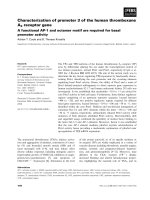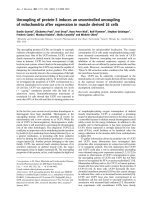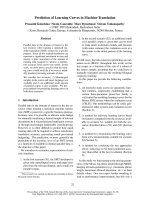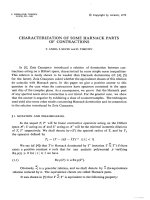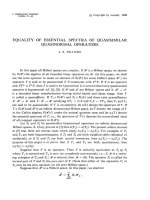Báo cáo toán học: "Subplanes of order 3 in Hughes Planes" ppt
Bạn đang xem bản rút gọn của tài liệu. Xem và tải ngay bản đầy đủ của tài liệu tại đây (119.25 KB, 8 trang )
Subplanes of order 3 in Hughes Planes
Cafer Caliskan
Department of Mathematical Sciences
Michigan Technological University
Houghton, MI 49931, U.S.A.
G. Eric Moorhouse
Department of Mathematics
University of Wyoming
Laramie, WY 82071, U.S.A.
Submitted: Nov 30, 2009; Accepted: Nov 23, 2010; Published: Jan 5, 2011
Mathematics Subject Classifications: 51E15
To Professor Spyros Magliveras on his 70th birthday
Abstract
In this study we show the existence of subp lanes of order 3 in Hughes planes of
order q
2
, where q is a prime power and q ≡ 5 (mod 6). We further show that there
exist finite partial linear spaces which cannot embed in any Hughes plane.
1 Introduction
L. Puccio and M. J. de R esmini [5] showed that subplanes of order 3 exist in the Hughes
plane of order 25. (We refer always to the ordinary Hughes planes; equivalently, all our
nearfields are regular.) Computations of the second author [2] show that among the
known projective planes of order 25 (including 99 planes up to isomorphism/duality),
exactly four have subplanes of order 3. These four planes are the ordinary Hughes plane
and three closely related planes. Recently, Caliskan and Magliveras [1] showed that there
are exactly 2 orbits o n subplanes of order 3 in the Hughes plane of order 121. In t his study
we show that every Hughes plane of order q
2
, where q is a prime power and q ≡ 5 (mod 6),
has subplanes of order 3.
We begin with the construction of the Hughes plane H(q
2
) of order q
2
, q an odd prime
power, as given by Rosati [6] and Za ppa [9]. Throughout this paper, K denotes a finite
field of order q
2
, and F its subfield of order q, where q is an odd prime power. For any
θ ∈ K with θ /∈ F, we have K = F[θ] and {1, θ} is a basis for K over F. We will always
choose θ such that θ
2
= d ∈ F, where d is a nonsquare in F. We now define the regular
nearfield N of order q
2
, where N has t he same elements a s K and t he same addition.
However, multiplication in N is defined as follows: a ◦ b = ab if a is a square in K, and
a ◦ b = ab
q
otherwise. Let V = {(x, y, z) | x, y, z ∈ N} be the 3-dimensional left vector
space over N. Define the set of points (set of lines) of H(q
2
) to be the set of all equivalence
the electronic journal of combinatorics 18 (2011), #P2 1
classes of elements of V {(0, 0, 0)}, under the equivalence (x, y, z) ∼ (k ◦ x, k ◦ y, k ◦ z)
([a, b, c] ∼ [k ◦ a, k ◦ b, k ◦ c]) for k ∈ N
∗
. It is occasionally convenient t o ‘normalize’ the
vector representatives (x, y, z) for po ints (using left-multiplication by element s of N
∗
) so
that their first nonzero coordinate is 1; co ordinates for lines may be similarly normalized.
We may take {1, θ} as a basis for N as a vector space over F. The incidence relation for
H(q
2
) is defined as follows : Point (x, y, z) is incident with line [a, b, c], where a = a
1
+a
2
θ,
b = b
1
+ b
2
θ, and c = c
1
+ c
2
θ, if and only if xa
1
+ yb
1
+ zc
1
+ (xa
2
+ yb
2
+ zc
2
) ◦ θ = 0.
It is well known that different choices of θ give isomorphic planes of order q
2
.
In order t o implement nearfield multiplication in N, the following is useful for readily
identifying squares in K.
Lemma 1.1 Consider a quadratic extension K = F[θ] ⊃ F where F is a field of odd
order q, and θ
2
= d ∈ F. A typical element x = a + bθ (where a, b ∈ F) is a square in K,
iff its norm x
q+1
= a
2
− db
2
is a square in F.
Proof: We may assume x = 0. The element x ∈ K is a square in K iff x
(q
2
−1)/2
= 1 iff
(x
q+1
)
(q−1)/2
= 1, iff the element x
q+1
∈ F is a square in F. Note that x
q+1
= x
q
x =
(a − bθ)(a + bθ) = a
2
− db
2
.
It has long been recognized by M. J. de Resmini and others that Hughes planes have
subplanes of order 2; for completeness we include a proo f of this fact in Section 2 . On the
other hand, this is not totally surprising since for a quadrilateral to g enerate a subplane
of order 2 only requires a single algebraic condition to hold. In order for a quadrilateral
to generate a subplane of order 3, several inequivalent conditions must hold. We show
the existence of subplanes of order 3 in the Hughes plane H(q
2
) in Section 3 in case q ≡ 5
(mod 12), and in Section 4 in case q ≡ 11 (mod 12).
2 Subplanes of order 2
We require the following technical lemma.
Lemma 2.1 Let F be a fi nite field of odd order q, and let d ∈ F be a nonsquare.
(a) If q ≡ 1 (mod 4) then there exists a nonzero element b ∈ F such that b
4
+ db
2
+ d
2
is a no nsquare in F.
(b) If q ≡ 3 (mod 4) then there exist (q + 1)/2 nonzero values of b ∈ F such that b
2
+ 1
is a no nsquare in F.
Proof: (a) The equation x
2
+dxz+d
2
z
2
= dy
2
defines a nondegenerate conic in the classical
projective plane coordinatized by F, with homogeneous coordinates (x, y, z). Since d is a
nonsquare in F, all q + 1 points of this conic must have xz = 0 and so all po ints of the
conic have the f orm (x, y, 1) with x = 0. No more than two such points share the same
x-coordinate, so the points (x, y, 1) of the conic have at least (q + 1)/2 distinct nonzero
the electronic journal of combinatorics 18 (2011), #P2 2
x-coordinates. Since F contains only (q −1)/2 nonsquares, the conic must contain a point
of the form (b
2
, y, 1) with b = 0.
(b) The equation x
2
+ y
2
+ z
2
= 0 defines a nondegenerate conic in the classical projective
plane coordinatized by F. Since −1 is a nonsquare in F, all q + 1 points of the conic have
the form (x, 1, z) in homogeneous coordinates with xz = 0. No more than two such points
(x, 1, ±z) share the same x- coordinate, yielding (q + 1)/2 values o f x for which x
2
+ 1
equals a nonsquare −z
2
.
Theorem 2.2 Every Hughes plane has a subplan e of order 2.
Proof: Let d be a nonsquare in F, so that K = F[θ] where θ ∈ K satisfies θ
2
= d. We
consider two cases.
Suppose first that q ≡ 1 mod 4. In this case −1 is a square in F, and θ is a nonsquare
in K since its norm θ
q
θ = (−θ)θ = −d is a nonsquare in F. Choose b ∈ F such that
b
4
+ db
2
+ d
2
is a nonsquare in F as in Lemma 2.1(a). Write c = (b/d) + (1/b) ∈ F, so that
1 ± cθ is a nonsquare in K by Lemma 1.1. The seven points p
0
, p
1
, . . . , p
6
of the Hughes
plane with coordinates
(1, 0, 0), (0, 1, 0 ), (1, −d/b, θ), (1, θ, b), (1/b, −(b/d)θ, 1), (1, b + θ, 0), (1, b, θ)
and the seven lines ℓ
0
, ℓ
1
, . . . , ℓ
6
with coordinates
[0, θ, −b], [0, 0, 1], [θ, 0, −1], [0, −b, θ], [−b, 0, 1], [−b − θ, 1, 1 + cθ], [−b − θ, 1, 1]
satisfy p
i
∈ ℓ
j
iff j − i ∈ {0, 1, 3} mod 7. This gives a subplane of order 2 in the Hughes
plane of order q
2
.
Now suppose that q ≡ 3 mod 4. In this case we may take d = −1, a nonsquare in F,
and θ is a square in K since its norm θ
q+1
= −d = 1 is a square in F. By Lemma 2.1(b),
there exists b ∈ F such that b
2
+1 is a nonsquare in F. By Lemma 1.1, the elements 1±bθ
and b ± θ are nonsquares in K. The seven point s of the Hughes plane
(1, 0, 0), (0, 1, 0 ), (0, 0, 1), ( 1 , θ, 0), (0, 1, 1 − bθ), (1, θ, b + θ), (1, 0, b + θ)
and the seven lines
[0, 0, 1], [1, 0, 0], [1, θ, 0], [−b − θ, −1 + bθ , 1], [0, −1 + bθ, 1], [−b − θ, 0, 1], [0, 1, 0]
give a subplane of order 2, where as before we have p
i
∈ ℓ
j
iff j − i ∈ {0, 1, 3} mod 7.
3 Case: q ≡ 5 (m od 12)
Let q ≡ 5 (mod 12). We may take d = −3, a nonsquare in F, and K = F[θ] where
θ
2
= −3. There is an element i ∈ F satisfying i
2
= −1, since q ≡ 1 (mod 4). Also
ω = (−1 + iθ)/ 2 ∈ K is a primitive cube root of unity, and the other is ω
2
= (−1 − iθ)/2.
Furthermore, ζ = iω = (−i + iθ)/2 ∈ K is a primitive 12-th root of unity. We compute
the electronic journal of combinatorics 18 (2011), #P2 3
that ζ
2
= (1 + θ)/2, ζ
4
= ω = (−1 + θ)/2 , and ζ
5
= iω
2
= (−i − iθ)/2. Moreover,
ζ + ζ
7
= ζ
2
+ ζ
8
= ζ
4
+ ζ
10
= ζ
5
+ ζ
11
= 0, since ζ
6
= −1. Hence, ζ
7
= (i − iθ)/2,
ζ
8
= (−1 − θ)/2, ζ
10
= (1 − θ)/2, and ζ
11
= (i + iθ)/2. The following Lemma follows
easily from Lemma 1.1.
Lemma 3.1 1 ± θ are squares and θ, 3 ± θ no t squares in K.
We now define α, a set of 13 points, and β, a set of 13 lines, as follows :
p
1
(0, 0, 1) ℓ
1
[0, 0, 1]
p
2
(0, 1, 0) ℓ
2
[0, 1, 0]
p
3
(0, 1, ζ) ℓ
3
[0, 1, ζ
5
]
p
4
(0, 1, ζ
7
) ℓ
4
[0, 1, ζ
11
]
p
5
(1, 0, 0) ℓ
5
[1, 0, 0]
α : p
6
(1, 0, ζ
2
) β : ℓ
6
[1, 0, ζ
4
]
p
7
(1, 0, ζ
8
) ℓ
7
[1, 0, ζ
10
]
p
8
(1, ζ, 0) ℓ
8
[1, ζ
5
, 0]
p
9
(1, ζ, ζ
2
) ℓ
9
[1, ζ
5
, ζ
4
]
p
10
(1, ζ, ζ
8
) ℓ
10
[1, ζ
5
, ζ
10
]
p
11
(1, ζ
7
, 0) ℓ
11
[1, ζ
11
, 0]
p
12
(1, ζ
7
, ζ
2
) ℓ
12
[1, ζ
11
, ζ
4
]
p
13
(1, ζ
7
, ζ
8
) ℓ
13
[1, ζ
11
, ζ
10
]
Theorem 3.2 Let q be a prime power, q ≡ 5 (mod 12). Then α is the set of points, and
β the set of lines, of a subplane of order 3 in the Hughes plane H(q
2
). This subplane is
invariant under the po l arity (x, y, z) ↔ [x
q
, y
q
, z
q
] of H(q
2
).
Proof: It is known that all elements of F are squares in K. We use the Lemma 3.1 and
the incidence relation described by Rosati [6] to determine whether p
i
and ℓ
j
are incident
for each pair of a p oint p
i
, 1 ≤ i ≤ 1 3, in α and a line ℓ
j
, 1 ≤ j ≤ 13, in β. This gives
rise to the following incidence matrix M:
M =
0 1 0 0 1 0 0 1 0 0 1 0 0
1 0 0 0 1 1 1 0 0 0 0 0 0
0 0 1 0 1 0 0 0 0 1 0 1 0
0 0 0 1 1 0 0 0 1 0 0 0 1
1 1 1 1 0 0 0 0 0 0 0 0 0
0 1 0 0 0 1 0 0 1 0 0 1 0
0 1 0 0 0 0 1 0 0 1 0 0 1
1 0 0 0 0 0 0 1 1 1 0 0 0
0 0 1 0 0 1 0 1 0 0 0 0 1
0 0 0 1 0 0 1 1 0 0 0 1 0
1 0 0 0 0 0 0 0 0 0 1 1 1
0 0 0 1 0 1 0 0 0 1 1 0 0
0 0 1 0 0 0 1 0 1 0 1 0 0
the electronic journal of combinatorics 18 (2011), #P2 4
An easy computation shows that MM
T
= J
13
+ 3I
13
, where J
13
denotes the 13 × 13
matrix in which every entry is a “ 1” and I
13
the 13 × 13 identity matrix.
By Rosati [7], the map (x, y, z) ↔ [x
q
, y
q
, z
q
] is a polarity of H(q
2
). One easily checks
that this map interchanges α and β. This completes the proof of Theorem 3.2.
4 Case: q ≡ 11 (mod 12)
Let us now assume that q ≡ 11 (mod 12), so t hat both −1 and −3 are nonsquares in F,
and in particular 3 is a square in F.
Lemma 4.1 There exists c ∈ F such that c
2
− c + 1 is a nonsquare in F.
Proof: By the Chevalley-Warning Theorem [8, p.5], there exist a, b, c ∈ F, not all zero,
such that c
2
− bc + b
2
+ a
2
= 0. Clearly b = 0, so (c/b)
2
− (c/b) + 1 = −(a/b)
2
, a nonsquare
in F.
Fixing c ∈ F as in Lemma 4.1, we readily obtain the following from the Lemma 1.1.
Lemma 4.2 The elements θ, 1 ± θ and 3 ± θ are squares in K. The elements c − 2 ± cθ,
c + 1 ± (c − 1)θ and 2c − 1 ± θ are nonsquares in K.
We shall use Lemma 4.2 along with the fa ct that c /∈ {0, 1}. Now we define α
′
, a set
of 13 points, and β
′
, a set of 13 lines, as fo llows :
p
1
(1, ω, ω
2
) ℓ
1
[1, ω, ω
2
]
p
2
(1, 0, −ω) ℓ
2
[0, −ω, 1]
p
3
(−ω, 1, 0) ℓ
3
[1, 0, −ω]
p
4
(0, −ω, 1) ℓ
4
[−ω, 1, 0]
p
5
(1/(c − 1), ω, ω
2
) ℓ
5
[ω
2
, c/(1 − c), ω]
α
′
: p
6
(−c, ω, ω
2
) β
′
: ℓ
6
[ω
2
, c − 1, ω]
p
7
((1 − c)/c, ω, ω
2
) ℓ
7
[ω
2
, −1/c, ω]
p
8
(ω
2
, (1 − c)/c, ω) ℓ
8
[ω, ω
2
, c/(1 − c)]
p
9
(ω
2
, 1/(c − 1), ω) ℓ
9
[ω, ω
2
, c − 1]
p
10
(ω
2
, −c, ω) ℓ
10
[ω, ω
2
, −1/c]
p
11
(ω, ω
2
, 1/(c − 1)) ℓ
11
[c − 1, ω, ω
2
]
p
12
(ω, ω
2
, −c) ℓ
12
[−1/c, ω, ω
2
]
p
13
(ω, ω
2
, (1 − c)/c) ℓ
13
[c/(1 − c), ω, ω
2
]
Theorem 4.3 Let q be a prime power, q ≡ 11 (mod 12). Then α
′
is the set of points,
and β
′
the set of lines, of a subplane of order 3 in the Hughes plane H(q
2
).
the electronic journal of combinatorics 18 (2011), #P2 5
Proof: By Lemma 4.1 and 4.2, our computation gives rise to the following incidence
matrix M
′
, where M
′
M
′
T
= J
13
+ 3I
13
. This proves Theorem 4.3.
M
′
=
1 1 1 1 0 0 0 0 0 0 0 0 0
1 0 0 0 1 1 1 0 0 0 0 0 0
1 0 0 0 0 0 0 1 1 1 0 0 0
1 0 0 0 0 0 0 0 0 0 1 1 1
0 1 0 0 1 0 0 1 0 0 1 0 0
0 1 0 0 0 1 0 0 1 0 0 1 0
0 1 0 0 0 0 1 0 0 1 0 0 1
0 0 1 0 1 0 0 0 0 1 0 1 0
0 0 1 0 0 1 0 1 0 0 0 0 1
0 0 1 0 0 0 1 0 1 0 1 0 0
0 0 0 1 1 0 0 0 1 0 0 0 1
0 0 0 1 0 1 0 0 0 1 1 0 0
0 0 0 1 0 0 1 1 0 0 0 1 0
5 Further Substructures of Hughes Planes
No subplanes of order 3 have ever been found in Hughes planes of order q
2
for q ≡
1 (mod 6); and computational evidence for small values of q suggests that subplanes o f
order 3 do not occur in this case. It is also an open problem whether there exists a Hughes
plane with a subplane of order 4. However, the following argument, first used in [3], shows
that there exist finite partial linear spaces which cannot embed in any Hughes plane.
First, some terminology: Let L be a finite partial linear space (a point-line incidence
structure, in which every line has at least two points, and any two distinct points lie on
at most one line of L). As before, we denote by H(q
2
) a Hughes plane of order q
2
. We say
that f : L → H(q
2
) is a n embedding if f injectively maps points of L to points of H(q
2
),
and f injectively maps lines of L to lines of H(q
2
), such that f(P ) lies on f (ℓ) (in H(q
2
))
if and only if the point P lies on the line ℓ (in L). (Replacing “if and only if” by “if” in
the latter definition, does not change the essential difficulty of the embedding problem, or
the validity of Theorem 5.1 below; see [3, Lemma 1].) In this language, our main result
(above) is that the projective plane of order 3 embeds in H(q
2
) whenever q ≡ 5 (mod 6).
Theorem 5.1 There exists a finite partial linear space which does not embed in any
Hughes plane.
Proof: Let L
0
be a finite partial linear space which does not embed in any Desarguesian
plane of odd order. (We may take L
0
to be a projective plane of order 2, or a configuration
violating Desargues’ Theorem.) Let Γ
0
be the incidence graph of L
0
, i.e. the graph whose
vertices correspo nd to points and lines of L
0
; and whose edges correspond to incident
point-line pairs of L
0
. Thus Γ
0
is a bipartite graph with no 4-cycle. By [4, Theorem 6.3]
(see also [3, Lemma 2]), there exists a bipartite graph Γ having no 4-cycle, such that for
every 2-coloring of the edges of Γ, there exists a subgraph isomorphic to Γ
0
, all of whose
the electronic journal of combinatorics 18 (2011), #P2 6
edges have the same color. We may regard Γ as the point-line incidence graph of a partial
linear space L.
Suppose that q is an odd prime power and that f : L → H(q
2
) is an embedding. For
each point P
i
and line ℓ
j
of L, denote f(P
i
) = (x
i
, y
i
, z
i
) and f(ℓ
j
) = [a
j
, b
j
, c
j
]. Here we
require the nonzero vectors (x
i
, y
i
, z
i
) and [a
j
, b
j
, c
j
] in N
3
to be ‘normalized’ to have first
nonzero coordinate equal to 1, as described in the Introduction. Now write
(a
j
, b
j
, c
j
) = (a
j1
+ a
j2
θ, b
j1
+ b
j2
θ, c
j1
+ c
j2
θ), (a
jk
, b
jk
, c
jk
) ∈ F
3
for all j, k, where {1, θ} is a fixed basis for K over F.
Assuming P
i
∈ ℓ
j
, we color the incident po int-line pair (P
i
, ℓ
j
) red or blue according
as a
j2
x
i
+ b
j2
y
i
+ c
j2
z
i
∈ K is a square or a nonsquare.
Case 1: Γ has a subgraph isomorphic to Γ
0
, all of whose edges are red. In this case the
map
P
i
→ (x
i
, y
i
, z
i
), ℓ
j
→ (a
j
, b
j
, c
j
)
restricts to an embedding of Γ
0
in a Desarguesian plane of order q
2
, since
a
j
x
i
+ b
j
y
i
+ c
j
z
i
= (a
j1
x
i
+ b
j1
y
i
+ c
j1
z
i
) + (a
j2
x
i
+ b
j2
y
i
+ c
j2
z
i
) ◦ θ = 0
for every red incident point-line pair P
i
∈ ℓ
j
. (The fact that vertices of Γ
0
are mapped
injectively to points and lines of the Desarguesian plane, follows from the fact that the
vectors (x
i
, y
i
, z
i
) have first nonzero coordinate 1 a nd so represent distinct 1-dimensional
subspaces of K
3
; similarly for the vectors [a
j
, b
j
, c
j
].) This contradicts the choice of Γ
0
.
Case 2: Γ has a subgraph isomorphic to Γ
0
, all of whose edges are blue. In this case the
map
P
i
→ (x
i
, y
i
, z
i
), ℓ
j
→ (a
q
j
, b
q
j
, c
q
j
)
restricts to an embedding of Γ
0
in a Desarguesian plane of order q
2
, since
a
q
j
x
i
+ b
q
j
y
i
+ c
q
j
z
i
= (a
j1
x
i
+ b
j1
y
i
+ c
j1
z
i
) + (a
j2
x
i
+ b
j2
y
i
+ c
j2
z
i
) ◦ θ = 0
for every blue incident point-line pair P
i
∈ ℓ
j
. (As in Case 1, injectivity of the embedding
of Γ
0
in the Desarguesian plane of order q
2
, follows from the fact that the vectors (x
i
, y
i
, z
i
)
and [a
j
, b
j
, c
j
] in N
3
are normalized.) Again, this contradicts the choice of Γ
0
.
The proof of Theorem 5.1 reveals a straightforward strategy for trying to embed a
given finite partial linear space L (such as a finite projective plane) in a Hughes plane
H(q
2
): Choose an appropriate 2-coloring of the incident point-line pairs of L (i.e. the
edges of its incidence graph Γ), such that both of the resulting monochromatic subgraphs
of Γ correspond to partial linear spaces embeddable in a Desarguesian plane of o r der q
2
.
Unfortunately there are exponentially many 2-colorings of the edges of Γ to consider; and
even for a projective plane of order 4, with 105 incident point-line pairs, this seems a
daunting task. On the other hand, it is easy to 2-color these 105 incident point-line pairs
without rendering any monochromatic subplane of order 2; so the argument of Theorem
5.1 seems ineffective in ruling out subplanes of order 4 in Hughes planes.
the electronic journal of combinatorics 18 (2011), #P2 7
Acknowledgments
We are grateful to the referee for catching errors in the original submitted version of this
work. The first author would also like to thank Professor Tim Pent tila for his valuable
suggestions and Professor Paul Yiu for his contributions in Field Theory.
References
[1] C. Caliskan and S. S. Magliveras, Subplanes of projective planes of order 12 1, J.
Geometry 97 no. 1 (2010), 17–27.
[2] G . E. Moorhouse, Projective planes o f order 25,
/>[3] G . E. Moo r house and J. Williford, Embedding finite partial linear spaces in finite
translation nets, J. Geometry 91 no. 1-2 (2009), 73–83.
[4] J. Neˇsetˇril and V. R¨odl, Strong Ramsey theorems for Steiner systems, Trans. Amer.
Math. Soc. 303 no. 1 (1987), 183–192.
[5] L. Puccio and M. J. de Resmini, Subplanes of the Hughes plane of order 25, Arch.
Math. 49 (1987), 151–165.
[6] L. A. Rosati, I gruppi di collineazioni dei piani di Hughes, Boll. Un. Mat. Ital. (3) 13
(1958), 505–513.
[7] L. A. Rosati, Unicit`a e autodualit`a dei piani di Hughes, Rend. Sem. Mat. Univ. Padova
30 (1960), 316–327.
[8] J P. Serre, A Course in Arithmetic, Springer-Verlag, New York, 1973.
[9] G . Zappa, Sui gruppi di gollineazioni dei piani di Hughes, Boll. Un. Mat. Ital. (3) 12
(1957), 507–516.
the electronic journal of combinatorics 18 (2011), #P2 8
